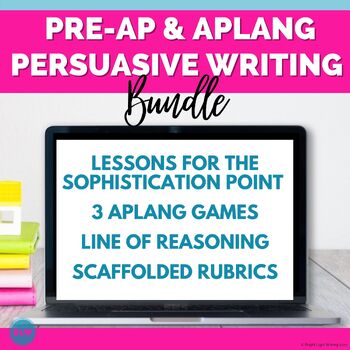Pre AP and APLang Persuasive Writing Bundle
- Zip

Products in this Bundle (7)
showing 1-5 of 7 products
Description
This Pre-AP & APLang Persuasive Writing Bundle includes everything you need to engage your students and prepare them for the argument and synthesis essays for the AP Language and Composition exam. Teaching line of reasoning, writing style, evidence in an essay, and precise language CAN be easy, engaging, and interactive! Increase your students’ confidence and competence the whole year, and inject some energy and fun into your review week with three APLang review games.
All materials included are Google Slide presentations and pdfs. Nearly all resources are provided in both digital and print formats.
1. Line of Reasoning Argument Writing APLang and Pre AP includes
- 6-Day Suggested Pacing Guide
- Teacher's Tips for Direct Instruction of Thinking Strategies and Ways to Explain Line of Reasoning
- Graphic Organizers (for students and teacher)
- Template for Planning an Argument Essay (with teacher tips)
- Five Activities (each includes warmup, cards, detailed student instructions, detailed teacher notes, student reflection questions, and teacher reflective wrap-up for the end of class)
- 36 Quickfire Prompts and Template to Create Your Own Prompts
2. Persuasive Writing Examples Game APLang includes
- Google Slideshow for 2 rounds of game prompts
- Anchor chart to teach CHORES (acronym to remember the different categories of examples students should consider)
- Teacher tips to teach with confidence
- Directions to play the game, including purpose and skills practiced
- Paper and digital game boards for students
3. How to Teach Writing Style Digital Activity includes 20 exercises to help you teach advanced punctuation and stylistic choices, specifically
- colons
- semi-colons
- dashes
- commas for nonessential clauses
- comma of omission
- parallel structure
- polysyndeton
- and more!
4. Writing Goals and Writing Rubrics From First Day to Final Reflection includes
- Detailed descriptions of the purpose and how to use every single tool, activity, and rubric in this bundle
- Tools and rubrics come in both paper and ready-to-type, customizable digital versions
- Getting to Know You as a Writer Student Survey (perfect for the first day of school)
- Writer’s Journal Prompts (to use over the course of the year)
- Guided Peer Feedback Tool (to ensure useful and actionable feedback to and from student writers)
- Small Group Feedback Organization Tool (to cut your grading time in half)
- 5 Strategies on Giving Effective Video Feedback (to make the learning stick)
- Writing Goal Self-Assessment with Quick Teacher Feedback Rubric (to use on “smaller” writing assignments and cut your grading time)
- 2 Versions of Writer’s Statement Prompts (one for longer written assignments and one for shorter assignments)
- 2 Metacognitive Rubrics (one for literary analysis and one for argument that list the questions students need to ask themselves during the planning and writing processes)
- Student Self-Assessment Tool (to use after full-length essays)
5. Precise Language Game APLang Multiple Choice includes
- Google Slideshow for directions, timer, and eye-opening challenge question after each round.
- 24 cards to print & cut for each round; 4 rounds total.
- Teacher tips to teach with confidence.
- Chart to reveal the answer to the challenge question after each round of play.
6. How to Integrate a Quote Presentation and Digital Practice includes a Google Slideshow, nine Google forms, answer key, and anchor chart to:
- show students why quoting words and phrases is a skill worth mastering
- teach students how to quote words and phrases accurately and effectively to prove a
particular point
- practice choosing parts of a quote to prove their claim
- practice embedding words and phrases directly into their own prose
- provide model examples of responses
- help your students MASTER this essential skill
7. Persuasive Writing Examples Game 2 APLang includes
- Google Slideshow for 2 rounds of game prompts (including visual rhetoric!)
- Anchor chart to teach CHORES (acronym to remember the different categories of examples students should consider)
- Teacher tips to teach with confidence
- Directions to play the game, including purpose and skills practiced
- Paper and digital game boards for students
Other resources you might like:
Personal Essay with Examples The Things They Carried (great for after the exam to start the college essay!)
10 No Prep or Low Prep Class Discussion Strategies with Rubric and Exit Tickets
Connotation Denotation Practice Activity
Follow me on TpT to learn when more resources become available and special sales.
Be sure to leave a review to earn TpT credits, which may be applied to your future purchases!





